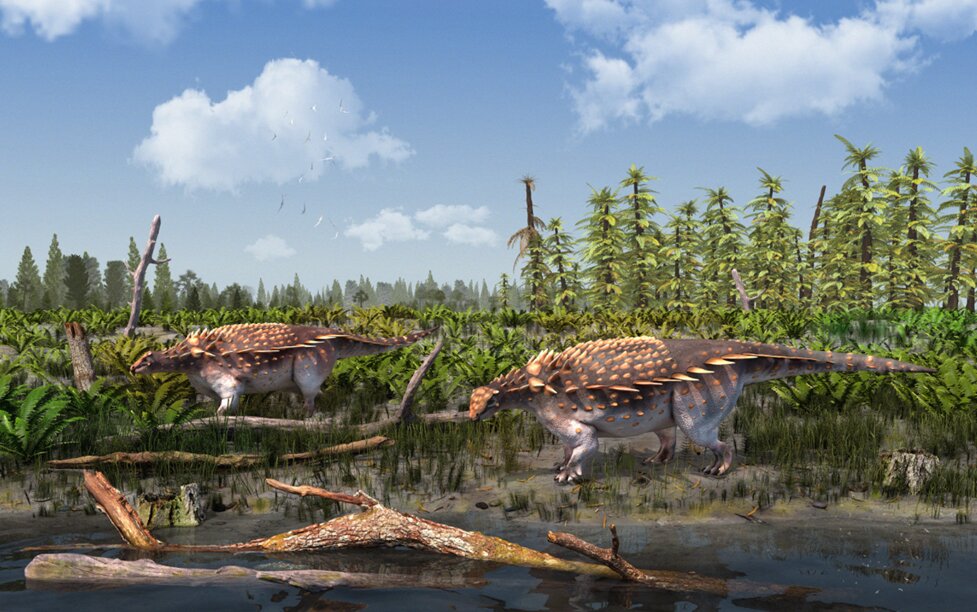
A new ankylosaur dinosaur has been discovered and named after Prof Paul Barrett of the Natural History Museum. The dinosaur, known as Vectipelta barretti, was found in the Wessex formation on the Isle of Wight, marking the first armored dinosaur to be described from the island in 142 years.
Lead author Stuart Pond emphasized the significance of this find, stating, “This specimen is important as it provides insights into the diversity of ankylosaurs in the Wessex formation and Early Cretaceous England. For over 140 years, all ankylosaur remains from the Isle of Wight were attributed to Polacanthus foxii. With the discovery of Vectipelta barretti, the interpretation of these finds needs to be revisited.”
Unlike Polacanthus foxii, which was previously the only known ankylosaur from the Isle of Wight, Vectipelta barretti exhibits several distinctive features. The fossilized remains show variations in the neck and back vertebrae, a different pelvic structure, and more blade-like spiked armor.
Through phylogenetic analysis, the researchers determined that Vectipelta barretti is most closely related to certain Chinese ankylosaurs, suggesting the migration of dinosaurs between Asia and Europe during the Early Cretaceous period.
Roaming the Earth during the Early Cretaceous, Vectipelta barretti provides insights into a time period for which fossil remains are scarce worldwide. The Wessex Formation and the Isle of Wight play a crucial role in understanding dinosaur diversity during this time, especially considering the lack of rocks from this period in North America. Some researchers speculate that a mass extinction event occurred at the end of the Jurassic, making the study of dinosaur diversity in the Early Cretaceous pivotal to understanding the aftermath of such an event and the subsequent recovery of life.
The Isle of Wight, with a climate similar to the Mediterranean at that time, was a floodplain with a large meandering river system. Floods would have brought together organic material such as plants, logs, and even dinosaur remains. As the waters receded, this organic matter would have accumulated in drying ponds on the floodplain and eventually been buried in clay soil, preserving it as fossils.
As a tribute to Prof Paul Barrett’s influence and expertise in vertebrate paleontology, the dinosaur was named after him. Dr. Susannah Maidment, senior author of the study, explained, “Paul has mentored or supervised several of us throughout our careers, and we noticed that he hadn’t been honored with a dinosaur name yet. He is a world-leading authority on dinosaurs and has greatly contributed to the field. Naming a slow-moving, spikey organism after him was a way to express our gratitude for his support and mentorship.”
Prof Paul Barrett has dedicated 20 years of his career to the Natural History Museum, London, publishing numerous scientific papers and mentoring numerous paleontologists, including 31 Ph.D. students.
Reflecting on the honor, Prof Barrett expressed his delight, saying, “I’m flattered and absolutely delighted to have been recognized in this way, especially considering that the first paper I ever wrote was also on an armored dinosaur in the NHM collections. Any physical resemblance is purely coincidental.”
The researchers are optimistic that more species will be discovered in the area in the future. Dr. Maidment concluded, “We have new iguanodontians waiting to be studied and prepped. I believe we have at least two new taxa in the collections. While ankylosaurs are rarer, we will keep our eyes open for any potential discoveries.”
The fossils of Vectipelta barretti are part of the valuable collection housed at the Dinosaur Isle Museum, operated by the Isle of Wight Council. Some parts of the dinosaur will be on display at the museum during the school holidays. The research was made possible through the dedicated efforts of the museum staff and volunteers who cleaned the bones and prepared them for study.
The study, titled “Vectipelta barretti, a new ankylosaurian dinosaur from the Lower Cretaceous Wessex Formation of the Isle of Wight,” is published in the Journal of Systematic Paleontology.
More information:
Vectipelta barretti, a new ankylosaurian dinosaur from the Lower Cretaceous Wessex Formation of the Isle of Wight, Journal of Systematic Palaeontology (2023). DOI: 10.1080/14772019.2023.2210577. www.tandfonline.com/doi/full/1 … 4772019.2023.2210577
Citation:
New armored dinosaur named for museum professor (2023, June 15)
retrieved 15 June 2023
from https://phys.org/news/2023-06-armored-dinosaur-museum-professor.html
This document is subject to copyright. Apart from any fair dealing for the purpose of private study or research, no
part may be reproduced without the written permission. The content is provided for information purposes only.
Denial of responsibility! SamacharCentrl is an automatic aggregator of Global media. In each content, the hyperlink to the primary source is specified. All trademarks belong to their rightful owners, and all materials to their authors. For any complaint, please reach us at – [email protected]. We will take necessary action within 24 hours.

Shambhu Kumar is a science communicator, making complex scientific topics accessible to all. His articles explore breakthroughs in various scientific disciplines, from space exploration to cutting-edge research.

